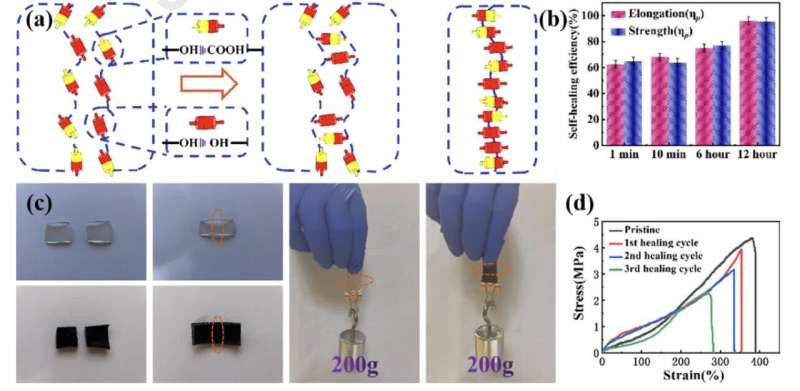June 2, 2023 feature
This article has been reviewed according to Science X's editorial process and policies. Editors have highlighted the following attributes while ensuring the content's credibility:
fact-checked
trusted source
proofread
A conductive self-healing hydrogel to create flexible sensors

Recent advancements in the field of electronics have enabled the creation of smaller and increasingly sophisticated devices, including wearable technologies, biosensors, medical implants, and soft robots. Most of these technologies are based on stretchy materials with electronic properties.
While material scientists have already introduced a wide range of flexible materials that could be used to create electronics, many of these materials are fragile and can be easily damaged. As damage to materials can result in their failure, while also compromising the overall functioning of the system they are integrated in, several existing soft and conductive materials can end up being unreliable and unsuitable for large-scale implementations.
Researchers at Harbin University of Science and Technology in China recently developed a new conductive and self-healing hydrogel that could be used to create flexible sensors for wearables, robots or other devices. This material and its composition was outlined in the Journal of Science: Advanced Materials and Devices.
"In this paper, polyvinyl alcohol (PVA) and 4-carboxylbenzaldehyde (CBA) were used to form a double network skeleton, and polyaniline (PANI) was introduced to assemble a flexible sensor with excellent self-healing performance," Xiaoming Wang, Ling Weng and their colleagues wrote in their paper. "The hydrophobic association of PVA and CBA guarantees the mechanical properties of the hydrogel sensor, and the introduction of PANI brings electrical properties to the hydrogel sensor."
Wang, Weng and their colleagues created their material by introducing CBA, an organic compound consisting of a benzene ring substituted with an aldehyde and carboxylic acid, into PVA, a water-soluble synthetic polymer, and adding the conducting polymer PANI via an electrostatic interaction. In initial tests, they found that the material had remarkable mechanical properties and could heal itself after being damaged. Moreover, it could reach a maximum stress of 4.35 Mpa and a maximum strain of 380%.
The researchers then used the material to create a strain sensor, a sensing device that can detect external forces and applied pressure originating from its surroundings. This sensor was found to perform very well, measuring both small deformation signals, such as a wearer coughing or speaking, as well as more vigorous body movements.
"The flexible sensor prepared in this article has a sensitivity of 1.71 in the strain range of 0–300%, and a limit detection strain of less than 1%," Wang, Weng and their colleagues wrote in their paper. "The response time of the hydrogel sensor during stretching is 158 ms. In addition, the hydrogel sensor also has self-healing performance. At room temperature, after the hydrogel is cut, it only takes one min to complete the repair, and the self-healing rate is about 60%."
In the future, the hydrogel created by this team of researchers could be used to develop a wide range of other sensors and wearable electronics, such as sensors that can detect human motion or medical devices that monitor specific biological signals. In addition, their work could pave the way for the development of similar flexible and conductive hydrogels with self-healing properties.
More information: Xiaoming Wang et al, Constructing conductive and mechanical strength self-healing hydrogel for flexible sensor, Journal of Science: Advanced Materials and Devices (2023). DOI: 10.1016/j.jsamd.2023.100563
© 2023 Science X Network





















